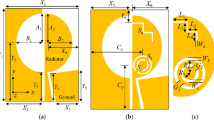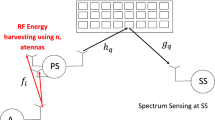Abstract
Most of the existing technologies for cognitive radio network (CRN) is essential for providing an effective solution for spectrum utilization problem in the wireless medium. Power allocation plays a dual and complex role in the multi-hop network, and these dual roles are known to be minimizing the total transmission power and also minimize the outage probability. Cognitive Radio technology enables a feasible way of using white spaces by incorporating diverse spectrum-sharing approaches. Interference makes efficient communication while sharing the channels among unlicensed and licensed users. In addition, Signal to Interference Noise Ratio also enhances the channel capacity. To investigate a joint channel and power allocation for CRNs, this paper aims to optimize the channel allocation and power control of secondary users to minimize interference between primary and secondary users and maximize throughput in CRN. This joint optimization is carried out with the combination of two renowned heuristic strategies that is termed Adaptive Luciferin Enhancement-based Team Work-Glowworm Optimization, which is carried out by deriving the multi-objective function regarding functions like Throughput and Interference. The analysis has demonstrated that the developed CRN framework has maximized the throughput of the CRN and also minimized the interference among the primary users over the existing power allocation strategies. Further, this model has enhanced the network lifetime and analyzed the convergence and complexity of the algorithm.




Similar content being viewed by others
Data Availability
No new data were generated or analyzed in support of this research.
Change history
06 June 2023
A Correction to this paper has been published: https://doi.org/10.1007/s10776-023-00598-7
References
H. Lei, H. Zhang, I. S. Ansari, Z. Ren, G. Pan, K. A. Qaraqe and A. M. S. Alouini, On secrecy outage of relay selection in underlay cognitive radio networks over Nakagami- $m$ fading channels, IEEE Transactions on Cognitive Communications and Networking, Vol. 3, No. 4, pp. 614–627, 2017.
P. D. Thanh, T. N. K. Hoan and I. Koo, Joint resource allocation and transmission mode selection using a POMDP-based hybrid half-duplex/full-duplex scheme for secrecy rate maximization in multi-channel cognitive radio networks, IEEE Sensors Journal, Vol. 20, No. 7, pp. 3930–3945, 2020.
Z. Wei and B. Hu, A fair multi-channel assignment algorithm with practical implementation in distributed cognitive radio networks, IEEE Access, Vol. 6, pp. 14255–14267, 2018.
F. Sheikholeslami, M. Nasiri-Kenari and F. Ashtiani, Optimal probabilistic initial and target channel selection for spectrum handoff in cognitive radio networks, IEEE Transactions on Wireless Communications, Vol. 14, No. 1, pp. 570–584, 2015.
C. Huang and L. Wang, Dynamic Sampling Rate Adjustment for Compressive Spectrum Sensing over Cognitive Radio Network, IEEE Wireless Commun. Lett., Vol. 1, No. 2, pp. 57–60, 2012.
X. Wang, Joint sensing-channel selection and power control for cognitive radios,", IEEE Transactions on Wireless Communications, Vol. 10, No. 3, pp. 958–967, 2011.
H. T. Thien, V. H. Vu and I. Koo, A transfer games actor-critic learning framework for anti-jamming in multi-channel cognitive radio networks, IEEE Access, Vol. 9, pp. 47887–47900, 2021.
H. Jiang, L. Lai, R. Fan and H. V. Poor, Optimal selection of channel sensing order in cognitive radio, IEEE Transactions on Wireless Communications, Vol. 8, No. 1, pp. 297–307, 2009.
J. Jeya, S. S. Kalamkar and A. Banerjee, Energy harvesting cognitive radio with channel-aware sensing strategy, IEEE Communications Letters., Vol. 18, No. 7, pp. 1171–1174, 2014.
F. Zhou, N. C. Beaulieu, Z. Li, J. Si and P. Qi, Energy-efficient optimal power allocation for fading cognitive radio channels: ergodic capacity, outage capacity, and minimum-rate capacity, IEEE Transactions on Wireless Communications, Vol. 15, No. 4, pp. 2741–2755, 2016.
D. Xu and Q. Li, Joint power control and time allocation for wireless powered underlay cognitive radio networks, IEEE Wireless Communications Letters, Vol. 6, No. 3, pp. 294–297, 2017.
Z. Chen, F. Gao, X. Zhang, J. C. F. Li and M. Lei, Sensing and power allocation for cognitive radio with multiple primary transmit powers, IEEE Wireless Communications Letters, Vol. 2, No. 3, pp. 319–322, 2013.
S. Li, S. Xiao, M. Zhang and X. Zhang, Power saving and improving the throughput of spectrum sharing in wideband cognitive radio networks, Journal of Communications and Networks, Vol. 17, No. 4, pp. 394–405, 2015.
S. Huang, H. Chen and Y. Zhang, Optimal power allocation for spectrum sensing and data transmission in cognitive relay networks, IEEE Wireless Communications Letters, Vol. 1, No. 1, pp. 26–29, 2012.
K. Illanko, M. Naeem, A. Anpalagan and D. Androutsos, Energy-efficient frequency and power allocation for cognitive radios in television systems, IEEE Systems Journal, Vol. 10, No. 1, pp. 313–324, 2016.
S. Wang, F. Huang and Z. Zhou, Fast power allocation algorithm for cognitive radio networks, IEEE Communications Letters, Vol. 15, No. 8, pp. 845–847, 2011.
S. Parsaeefard and A. R. Sharafat, Robust distributed power control in cognitive radio networks, IEEE Transactions on Mobile Computing, Vol. 12, No. 4, pp. 609–620, 2013.
A. Paul and S. P. Maity, On outage minimization in cognitive radio networks through routing and power control, Wireless Personal Communications, Vol. 98, pp. 251–269, 2018.
K. K. Anumandla, S. L. Sabat, R. Peesapati, A. V. Prabu, J. R. K. K. Dabbakuti and R. Rout, Optimal spectrum and power allocation using evolutionary algorithms for cognitive radio networks, Internet Technology Letters, 2020. https://doi.org/10.1002/itl2.207.
X. He, H. Jiang, Y. Song, Y. Luo and Q. Y. Zhang, Joint optimization of channel allocation and power control for cognitive radio networks with multiple constraints, Wireless Networks, Vol. 26, No. 1, pp. 101, 2020.
X. Kang, Optimal power allocation for bi-directional cognitive radio networks with fading channels, IEEE Wireless Communications Letters, Vol. 2, No. 5, pp. 567–570, 2013.
C. L. Chuang, W. Y. Chiu and Y. C. Chuang, Dynamic multiobjective approach for power and spectrum allocation in cognitive radio networks, IEEE Systems Journal, Vol. 15, No. 4, pp. 5417–5428, 2021.
X. Kang, R. Zhang, Y. Liang and H. K. Garg, Optimal power allocation strategies for fading cognitive radio channels with primary user outage constraint, IEEE Journal on Selected Areas in Communications, Vol. 29, No. 2, pp. 374–383, 2011.
G. Peter, J. Livin and A. Sherine, Hybrid optimization algorithm based optimal resource allocation for cooperative cognitive radio network, Array, 2021. https://doi.org/10.1016/j.array.2021.100093.
H. W. Lee, W. Chang and B. C. Jung, Optimal power allocation and allowable interference shaping in cognitive radio networks, Computers & Electrical Engineering, Vol. 71, pp. 265–272, 2018.
Y. Zhou, G. Zhou, Y. Wang and G. Zhao, A glowworm swarm optimization algorithm based tribes, Applied Mathematics & Information Sciences, Vol. 7, No. 2L, pp. 537–541, 2013.
M. Dehghani and P. Trojovský, Teamwork optimization algorithm: a new optimization approach for function minimization/maximization, Sensors, Vol. 21, No. 4567, pp. 1–10, 2021.
W. F. Fihri, H. E. Ghazi and B. A. E. Majd, A multi-objective particle swarm optimization based algorithm for primary user emulation attack detection, Wireless Personal Communications, Vol. 117, pp. 867–886, 2021.
G. Eappen and T. Shankar, Multi-objective modified grey wolf optimization algorithm for efficient spectrum sensing in the cognitive radio network, Arabian Journal for Science and Engineering, Vol. 46, pp. 3115–3145, 2021.
J. L. Tabjula, S. Kanakambaran, S. Kalyani, P. Rajagopal and B. Srinivasan, Outlier analysis for defect detection using sparse sampling in guided wave structural health monitoring, Structural Control and Health Monitoring, 2021. https://doi.org/10.1002/stc.2690.
J. Tabjula, S. Kalyani, P. Rajagopal and B. Srinivasan, Statistics-based baseline-free approach for rapid inspection of delamination in composite structures using ultrasonic guided waves, Structural Health Monitoring, Vol. 21, pp. 2719, 2021.
D. Roy and M. Dutta, A systematic review and research perspective on recommender systems, Journal of Big Data, Vol. 9, pp. 59, 2022.
S. Rajkumar and C. Rebeiro, Implementation of cryptographic primitives, International Journal of Engineering Trends and Technology, Vol. 49, No. 4, pp. 264, 2017.
S. Rajkumar, Implementing software defined load balancer and firewall, International Journal of Scientific Research and Engineering Development, Vol. 5, No. 5, pp. 300–304, 2022.
L. S. Ambati, K. Narukonda, G. R. Bojja and D. Bishop, Factors influencing the adoption of artificial intelligence in organizations-from an employee’s perspective, Dakota State University, 2020.
Author information
Authors and Affiliations
Corresponding author
Ethics declarations
Conflict of interest
The authors declare no conflict of interest.
Additional information
Publisher's Note
Springer Nature remains neutral with regard to jurisdictional claims in published maps and institutional affiliations.
The original online version of this article was revised: the co-authors are linked with their correct affiliations.
Rights and permissions
Springer Nature or its licensor (e.g. a society or other partner) holds exclusive rights to this article under a publishing agreement with the author(s) or other rightsholder(s); author self-archiving of the accepted manuscript version of this article is solely governed by the terms of such publishing agreement and applicable law.
About this article
Cite this article
Babu, T.S., Rao, S.N. & Satyanarayana, P. A Design of Minimizing Interference and Maximizing Throughput in Cognitive Radio Network by Joint Optimization of the Channel Allocation and Power Control. Int J Wireless Inf Networks 30, 211–225 (2023). https://doi.org/10.1007/s10776-023-00592-z
Received:
Revised:
Accepted:
Published:
Issue Date:
DOI: https://doi.org/10.1007/s10776-023-00592-z




